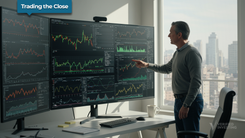Trading The Close Market Recap - 10/30/2025: Tech Pullback — Semiconductor 'Canary' Signals as S&P Tests COVID-Era Trendline

The market flashed significant warning signs today as downside pressure mounted, particularly in the high-flying tech sector. Major names like Meta and Chipotle suffered dramatic post-earnings declines, while the broader indices tested critical long-term support levels. In this afternoon's Trading The Close, Pro Trader Drew Dosek of Verified Investing broke down the technical signals that foreshadowed this weakness and highlighted the key levels that could determine the market's next major move.
Today's article will expand on the crucial themes from the show, providing deeper context on the sector rotation, the ominous technical patterns in key indices, and the powerful lessons from this week's volatile earnings reactions.
A Market Divided: The Rotation into Defensives
While the headline numbers showed a sea of red, a more nuanced story was unfolding beneath the surface. The Nasdaq Composite fell approximately 1.5% and the S&P 500 dropped nearly 1%, but the Dow Jones Industrial Average held its ground, showing relative strength. This divergence wasn't random; it was a clear signal of sector rotation.
As Drew explained, "Dow Jones actually staying a little bit stronger. And the reason being, there's more defensive plays there in the Dow Jones… money rotation is going out of tech and into some more defensive plays."
This phenomenon is a classic late-cycle market behavior. When uncertainty rises and the high-growth names that led the rally (like Nvidia, down 2.06%, and Microsoft, down 2.89%) begin to falter, institutional capital often seeks refuge in more stable, less volatile sectors. These "defensive" industries—such as consumer staples, utilities, and certain healthcare or industrial companies found in the Dow—tend to have more predictable cash flows and are less sensitive to economic downturns.
For traders, recognizing this rotation is critical. It signals a shift in market sentiment from "risk-on," where speculative growth is rewarded, to "risk-off," where capital preservation becomes the priority. The weakness in risk assets was further confirmed by Bitcoin, which fell 3% to trade under $110,000, reinforcing its role as a barometer for market risk appetite.
The S&P 500 at a COVID-Era Crossroads
The S&P 500 chart is currently positioned at one of the most significant technical junctures in recent memory. The index is sitting just above the top of a massive, inclining parallel channel that originates from the COVID lows in 2020. This trendline represents the primary long-term uptrend that has defined the market for over four years.
Currently, this line is acting as minor support around the 679.06 level on the S&P 500 ETF, the SPY. However, its position is precarious. The price action leading up to this test, including a narrow-bodied doji candle on Tuesday, mirrored a similar pattern from the prior week that ultimately resolved to the downside. This sets up a potential bull trap scenario, where a brief move above a key resistance level fails, trapping optimistic buyers before reversing lower.
A break below this multi-year channel would be a significant technical event. It would suggest that the long-term uptrend is, at a minimum, being seriously challenged. This is where one of the most important adages in trading comes into play, a concept Drew frequently emphasizes: "The stocks take the elevator down when they're selling off. They take the stairs up and then the elevator down."
This quote perfectly captures the psychology of market cycles. Bull markets tend to be a slow, grinding ascent as confidence gradually builds. Bear markets or sharp corrections, however, are often swift and brutal, driven by fear and panic. A break of a level as significant as the COVID-era trendline could trigger this "elevator down" effect, causing price to slice through multiple support levels quickly. The first major support below the channel sits at 672.06, but in a true risk-off environment, even that may not hold for long.
The Semiconductor Canary: An Ominous Warning
Often, the semiconductor sector (represented by the SMH ETF) acts as a leading indicator, or a "canary in the coal mine," for the broader technology market and the economy. Yesterday, the SMH provided a textbook technical sell signal that perfectly illustrates the power of multi-factor analysis.
Drew highlighted a setup he calls the "Sleeper Hold," which correctly predicted today's downturn. The signal was a confluence of three distinct factors:
- A Time Count: A proprietary timing methodology that suggested a turn in price was imminent.
- A Long-Term Trendline: A trendline drawn from the May 14th pivot, connecting subsequent highs, converged precisely at yesterday's high, providing clear resistance.
- A Narrow Body Bar: The price action formed a doji candle, indicating indecision and a potential exhaustion of the uptrend right at that resistance.
As Drew explained, "We had a beautiful time count. We needed resistance. We had the narrow body bar. The resistance is displayed with this longer term trend line. And then, boom, just like that, price comes right back down."
This setup presented a high-probability short trade at yesterday's close, which paid off handsomely today. However, there's a crucial caveat. The SMH had previously confirmed a breakout above its primary inclining parallel channel. This makes the current situation even more critical. The top of that channel, now at $362.52, should act as support. A failure to hold this level—a break back inside the channel—would be an exceptionally bearish signal, suggesting the prior breakout was a false move. Such a failure could open the door to a much deeper correction, potentially targeting levels under $350.
Earnings Aftershocks: When Technicals Tell the Story
This earnings season has been a tale of two cities, with Google rocketing higher yesterday while Meta and Chipotle collapsed today. In each case, however, the charts provided a clear roadmap for the price action that followed.
Meta (META): The more than 10% collapse in Meta's stock was not a surprise to those watching the technicals. As Drew pointed out, the move was foreshadowed weeks ago by a classic head and shoulders topping pattern. This pattern generated a measured move target of $656.45. Today's low was $650.17. The technical pattern perfectly predicted the magnitude of the decline, providing a clear target for short-sellers and a warning for longs. The chart is now severely damaged, with the next major support level at $637.63.
Chipotle (CMG): Chipotle’s brutal decline was also preceded by clear technical warnings. The stock had been trading within a declining parallel channel. While these channels are often bullish and resolve with a breakout to the upside, a break to the downside is a rare and powerfully bearish signal. Chipotle gave traders two days of warning, closing beneath the channel on both Tuesday and Wednesday before the earnings report. This was a clear sign that sellers were in control. The stock is now fighting to stay above a critical long-term support level at $33.63, a level that contained all the price action of 2022 and 2023. A failure to reclaim this level would be catastrophic for the stock.
Google (GOOGL): Even on the upside, technicals defined the move. After its initial earnings spike, Google's rally stopped on a dime. The reason? It ran perfectly into the top of a steep, newly identified parallel channel. The high of the day came right at the upper boundary of this channel, around $291.60, before sellers took control. This demonstrates the precision of technical analysis; even in a moment of extreme bullish enthusiasm, pre-defined resistance levels held firm. The stock now has a lot of "air" beneath it, with initial support not appearing until $266.76.
A Global View: Commodities, Currencies, and Viewer Requests
The current market weakness isn't confined to US equities. A look at other asset classes confirms the risk-off tone.
- Gold and Silver: An interesting divergence is occurring in precious metals. Gold, after breaking a key trendline, popped higher today but appears to be merely re-testing that broken line as resistance around $4,048.20. Silver, however, is showing relative strength, having already reclaimed its prior consolidation range. This suggests Silver may have more near-term upside potential, with resistance at $50.67.
- Cattle: In response to a viewer request, Drew analyzed the cattle futures chart, which has seen a dramatic drop. This move was driven by fundamental news, including a call from Donald Trump to reduce beef costs and the prospect of importing low-tariff beef from Argentina and Mexico. From a technical standpoint, price found support at a key pivot from June 9th at $2.25. The next major downside target, derived from a long-term trendline, is $2.21.
- FTSE 100: Another viewer request focused on the UK's primary stock index. The FTSE has rallied strongly since April but has now run directly into resistance at the 50% median line of its long-term parallel channel, located at 9,789 points. A failure to break through this level would likely send the index back down to the bottom of the channel near 9,486.
The Art and Science of Reading the Charts
A key lesson from today's show was the dual nature of technical analysis—it is both an art and a science. The "art" was demonstrated on the Apple chart, where Drew showed how multiple valid parallel channels could be drawn using different pivot points. The key, he stressed, is to have at least three connecting pivots to validate a trendline.
The "science" was evident in the oil chart analysis. Price is currently chopping sideways after a steep decline, consolidating right above a support zone created by the wicks and candles from mid-October. As Drew eloquently stated, "It's not by coincidence. This is how technical analysis works. Everything displayed on the chart you can make and create reasoning for why price is getting a bounce, likely from previous price action. It's truly beautiful once you understand and are able to read the charts with the technical mindset." This principle—that past price action dictates future support and resistance because it reflects the collective memory and behavior of market participants—is the scientific foundation upon which all technical analysis is built.
Conclusion: Brace for Impact
The market is at a critical inflection point. The rotation out of technology and into defensive assets, combined with key indices testing major long-term support levels, signals a significant shift in investor sentiment. The powerful sell signal on the semiconductor ETF served as a warning shot, and the brutal post-earnings reactions in names like Meta and Chipotle show how quickly sentiment can sour.
As we head into the end of the week, with Apple's earnings still on deck, the market's direction hangs in the balance. The charts have provided a clear roadmap of the key levels to watch. Whether support holds and the bulls regroup, or whether the "elevator down" scenario begins to play out, will likely be determined in the coming sessions. For now, caution is warranted, and a deep respect for pre-defined technical levels is more important than ever.
Trading involves substantial risk. All content is for educational purposes only and should not be considered financial advice or recommendations to buy or sell any asset. Read full terms of service.




